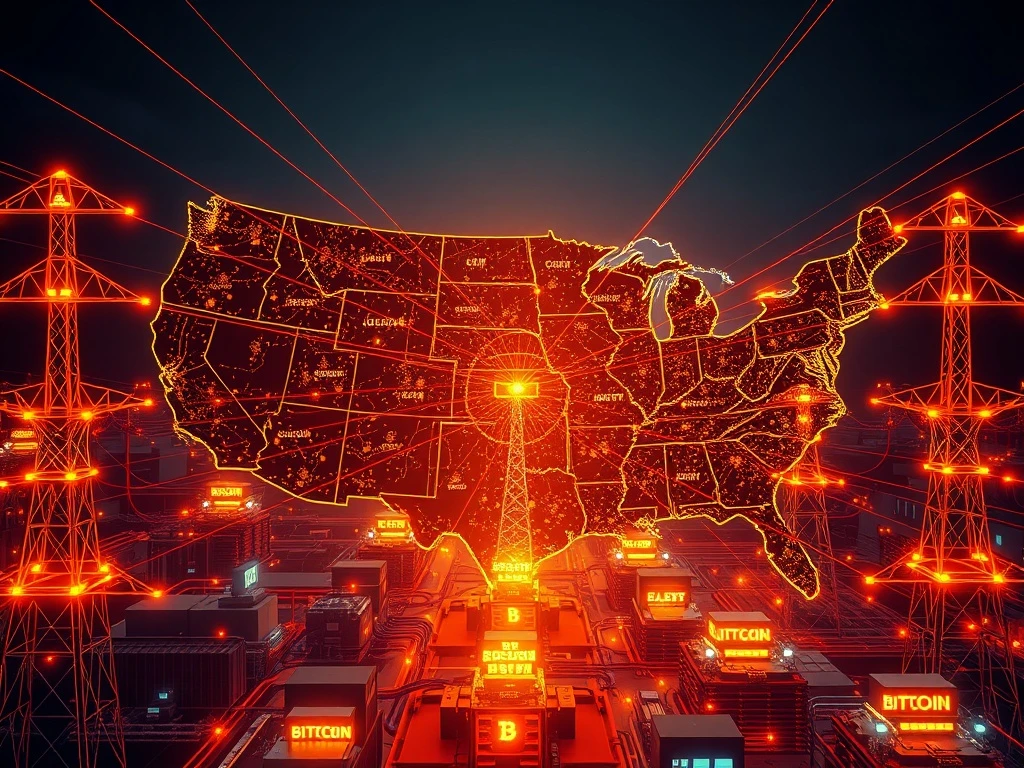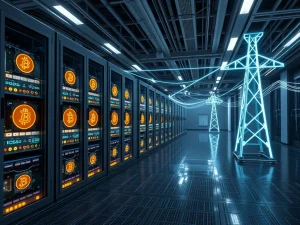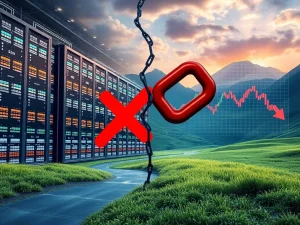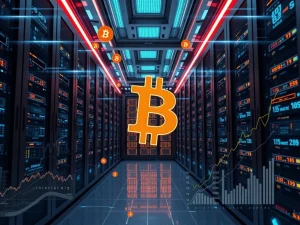Bitcoin Mining & AI: US Energy Secretary Unveils Faster Grid Access Plan

The landscape of large-scale power consumption in the United States stands on the cusp of a significant transformation. Specifically, for those invested in digital assets, this news carries immense weight. The US government is now actively addressing the growing energy demands of sectors like **Bitcoin mining** and artificial intelligence. This move could fundamentally reshape how these industries connect to and interact with the nation’s power infrastructure.
US Energy Secretary Champions Expedited Grid Access
In a crucial development, the US Secretary of Energy has urged the Federal Energy Regulatory Commission (FERC) to implement new rules. These proposed regulations aim to accelerate the process for major electricity consumers, including **AI data centers** and **Bitcoin mining** operations, to connect directly to the national power grid. This initiative highlights a proactive approach to managing the surging electricity demand driven by technological advancements.
On Thursday, US Energy Secretary Chris Wright released a letter detailing this request. He specifically asked FERC, the independent body overseeing the interstate electricity grid, to streamline reviews. Furthermore, he advocated for standardized procedures. These changes would allow large electricity users to directly access the high-voltage transmission system, moving beyond local power lines. The high-voltage system offers a significantly greater capacity, ideal for facilities with substantial power requirements.
Wright emphasized the extraordinary pace of electricity demand growth across the United States. He attributed much of this surge to the rapid expansion of large-scale loads. “Although there are several drivers to this demand growth, such as home and vehicle electrification, increasing quantities of large commercial and industrial load, most notably data centers, are connecting rapidly to the transmission system,” Wright wrote. This statement underscores the critical need for updated infrastructure policies.
Benefits for Bitcoin Mining and AI Data Centers
The proposed **FERC regulations** would bring substantial advantages to both **Bitcoin mining** companies and **AI data centers**. These industries are known for their intensive power consumption. S. Matthew Schultz, CEO of the Bitcoin mining firm CleanSpark, promptly commented on the potential impact. In an X post on Friday, Schultz stated that the new rules would mandate FERC to expedite connections for “flexible loads like Bitcoin mining and data centers.”
Schultz further elaborated on the significance of this shift. He noted, “This is a major signal that DOE recognizes the value of flexible demand in strengthening the grid.” This acknowledgment suggests a strategic understanding within the Department of Energy regarding the role these industries can play in grid stability. Bitcoin miners, for instance, require considerable power to run their rigs. These rigs validate transactions and create new blocks, contributing to network security through increased hashrate.
CleanSpark’s perspective highlights the operational efficiencies and potential for growth that faster grid integration offers. As a result, companies like CleanSpark could deploy new mining facilities more quickly. This would not only benefit their operations but also contribute to the overall resilience of the **US energy grid** by integrating flexible demand resources more effectively.
Streamlined Review Process: Years to Days
One of the most impactful aspects of Wright’s proposal involves drastically shortening the review period for grid connections. Under the suggested new rules, the approval process for large power users could be completed in just 60 days. This represents a monumental improvement from the current system, which often takes years. This accelerated timeline would apply provided the applicant meets specific criteria. A key condition includes agreeing to cover the costs of any necessary network upgrades.
This expedited review process could unlock significant growth opportunities for the affected industries. The lengthy wait times have historically been a major bottleneck for expansion. By reducing this bureaucratic hurdle, the US aims to foster innovation and investment. Wright has asked FERC to respond to his letter within six months, setting a deadline of April 30, 2026. This timeframe indicates a clear intent to move forward swiftly with these reforms.
The competition for access to affordable and sustainable energy has intensified among **Bitcoin mining** companies and artificial intelligence data centers. This push for **expedited grid access** is therefore timely. Experts suggest that such improvements could attract renewed institutional investment over the next decade. The ability to connect quickly and reliably to power sources is a critical factor for business planning and scaling operations in these energy-intensive sectors.
The Broader Impact on the US Energy Grid and Economy
The proposed changes extend beyond mere convenience for energy-intensive industries. They reflect a strategic effort to modernize and strengthen the **US energy grid** itself. By standardizing procedures and reducing connection times, the grid can adapt more readily to evolving energy demands. This proactive stance is crucial as new technologies continue to emerge and require substantial power resources.
Integrating large, flexible loads like Bitcoin mining operations can offer benefits to grid operators. These facilities can, in some cases, act as ‘demand response’ participants. They can curtail their energy use during peak demand periods, helping to stabilize the grid. This flexibility is a valuable asset, especially as renewable energy sources, which are inherently intermittent, become more prevalent.
Ultimately, these regulatory adjustments could position the United States as a more attractive destination for technology and innovation. By facilitating easier and faster grid connections, the nation can support the growth of both the burgeoning AI sector and the robust cryptocurrency mining industry. This forward-thinking approach to energy infrastructure promises to yield economic advantages and technological leadership for years to come.










